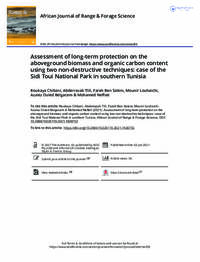Assessment of long-term protection on the aboveground biomass and organic carbon content using two non-destructive techniques: case of the Sidi Toui National Park in southern Tunisia

Authors:
Long-term protection of arid ecosystems changes the vegetation and soil structures. The quantification of aboveground biomass and carbon content are among the principal indicators to evaluate these changes. Most methods used to quantify these parameters are costly, time consuming and destructive. In this paper, two non-destructive methods were compared: digital image processing and biometric measurements. Aboveground biomass and carbon content of five perennial shrubs were studied inside and outside Sidi Toui National Park, southern Tunisia. The effect of long-term protection on aboveground biomass and carbon content was assessed. The main results indicated that both methods provided similar aboveground biomass and carbon values. Aboveground biomass and carbon content were strongly correlated with canopy cover and biovolume (R2 ˃ 0.7). Positive linear relationships were found for all the studied species. Apart from the large canopy cover of Haloxylon schmittianum and Haloxylon scoparium, the obtained results showed that long-term protection had no significant effect on aboveground biomass and carbon content for the other species. These results suggest that digital charting technique is an accurate method for assessing rangeland productivity in a timely and cost-efficient manner and that long-term protection is not always suitable for enhancing carbon content and therefore ecosystem resilience under climate change conditions.
